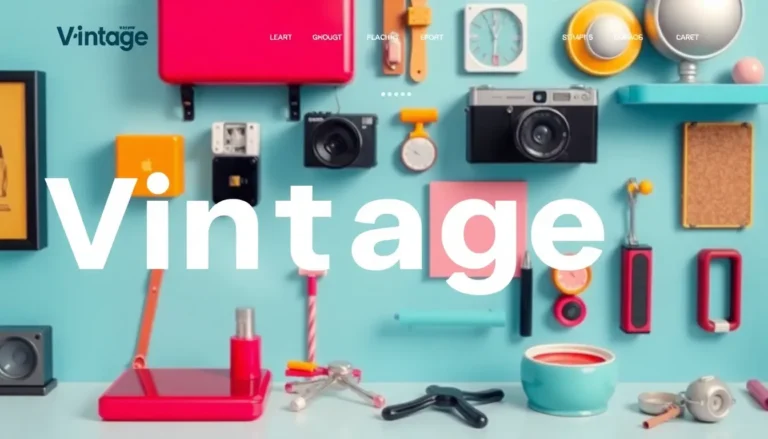In the fast-paced world of e-commerce, cart functionality coding is the unsung hero that keeps the digital shopping experience smooth and seamless. Imagine a world where customers can add items to their cart without a hitch, and checkout feels as easy as pie. It’s not just about coding; it’s about crafting a delightful journey that turns casual browsers into loyal buyers.
Table of Contents
ToggleUnderstanding Cart Functionality Coding
Cart functionality coding plays a vital role in e-commerce platforms. Effective implementation significantly enhances the user experience, leading to higher conversion rates.
Importance of Cart Functionality
Cart functionality directly influences user engagement. When customers can easily add items to their carts, they spend more time on the site. A streamlined checkout process encourages them to complete their purchases. Additionally, effective coding minimizes cart abandonment, which often occurs due to cumbersome navigation or unclear processes. Data from the Baymard Institute indicates that 69.8% of online shoppers abandon their carts, underscoring the need for optimized cart features. Engaging cart designs not only support customer satisfaction but also foster loyalty, converting casual viewers into repeat customers.
Key Components of Shopping Carts
Shopping carts consist of several key components that enhance usability. Item listings display product details, including quantities and prices. A clearly visible checkout button ensures easy navigation through the purchasing process. Users benefit from a mini cart, showing a quick summary of selected items without navigating away from the product page. Secure payment gateways facilitate safe transactions, contributing to customer trust. Session management retains user data across multiple visits, allowing for a seamless shopping experience. Implementing these components ensures a functional and efficient cart system, leading to improved sales performance and customer retention.
Best Practices for Cart Functionality Coding
Creating a user-friendly shopping cart is vital for generating sales and enhancing customer satisfaction. Effective coding can significantly improve the shopping experience for online users.
User Experience Considerations
Prioritize intuitive design elements, such as visible checkout buttons and consistent layouts. Provide clear progress indicators during the checkout process to guide users smoothly. Engaging mini carts allow customers to quickly view selected items without navigating away from current pages. Offer features like save-for-later options to enhance personalization, addressing specific shopper preferences. Keeping loading times minimal also plays a critical role, as delays can lead to frustration and cart abandonment. Regular testing and user feedback help refine the cart experience, ensuring it meets user expectations.
Security Measures
Implementing robust security measures builds trust and encourages transactions. Use SSL encryption to protect sensitive data during checkout, safeguarding customer information from potential breaches. Regularly update payment gateways and ensure compliance with PCI DSS standards. Display trust badges prominently to reassure users about the safety of their purchases. Include clear return and privacy policies, as transparent communication fosters confidence. Continually monitoring for vulnerabilities and addressing them proactively enhances overall security and user trust.
Common Challenges in Cart Functionality Coding
Cart functionality coding presents several challenges that developers encounter frequently. Addressing these challenges ensures an efficient and user-friendly shopping experience.
Handling Inventory Issues
Managing inventory accurately proves essential for cart functionality. Misalignments between available stock and cart items often lead to customer frustration. A robust inventory management system keeps real-time data about product availability. In instances where stock levels change rapidly, notifying customers about low stock is crucial. Additionally, implementing features like product reservation can secure items temporarily for users, thus enhancing their shopping experience. An efficient inventory integration can minimize mistakes and optimize overall performance.
Managing User Sessions
User session management plays a vital role in maintaining a seamless shopping journey. Tracking user behaviors across sessions allows for personalized experiences. Incorporating session persistence ensures that users do not lose their cart items when navigating away from the site. Moreover, setting time limits on inactive sessions can help optimize server resources while protecting sensitive information. Implementing user-friendly solutions like “remember me” features boosts convenience, fostering customer loyalty. Efficient management helps retain users and converts potential drop-offs into successful transactions.
Tools and Technologies for Cart Functionality Coding
Developing cart functionality requires a solid understanding of various tools and technologies. These components support a seamless and efficient shopping experience for users.
Popular Programming Languages
JavaScript serves as the backbone for interactive web applications, making it essential for cart functionality. PHP aids in server-side processing, handling data inputs and managing sessions effectively. Python’s simplicity enhances rapid development, enabling seamless integration with web apps. Ruby, often used with Ruby on Rails, provides a robust framework for e-commerce sites, streamlining cart operations. Each language supports dynamic features that enhance user engagement.
Frameworks and Libraries
React stands out for building user interfaces, offering reusable components that speed up development. Angular, a powerful framework, enables the creation of single-page applications that improve user experience. jQuery simplifies JavaScript coding, allowing developers to implement cart features smoothly. Bootstrap offers responsive design elements that ensure carts look appealing across devices. Each framework or library allows for a more functional shopping cart, increasing conversion rates and reducing abandonment.
Conclusion
Mastering cart functionality coding is essential for any e-commerce platform aiming to thrive in a competitive market. By prioritizing user experience through intuitive designs and robust security measures, businesses can significantly enhance customer satisfaction and loyalty.
Addressing common challenges like inventory management and session handling ensures a seamless shopping experience that keeps users engaged. Leveraging the right tools and technologies empowers developers to create dynamic and visually appealing carts that drive conversions.
Ultimately, investing time and resources into effective cart functionality not only reduces cart abandonment but also transforms casual visitors into dedicated customers.




